light MERCEDES-BENZ GLE SUV 2019 Owners Manual
[x] Cancel search | Manufacturer: MERCEDES-BENZ, Model Year: 2019, Model line: GLE SUV, Model: MERCEDES-BENZ GLE SUV 2019Pages: 681, PDF Size: 11.7 MB
Page 5 of 681
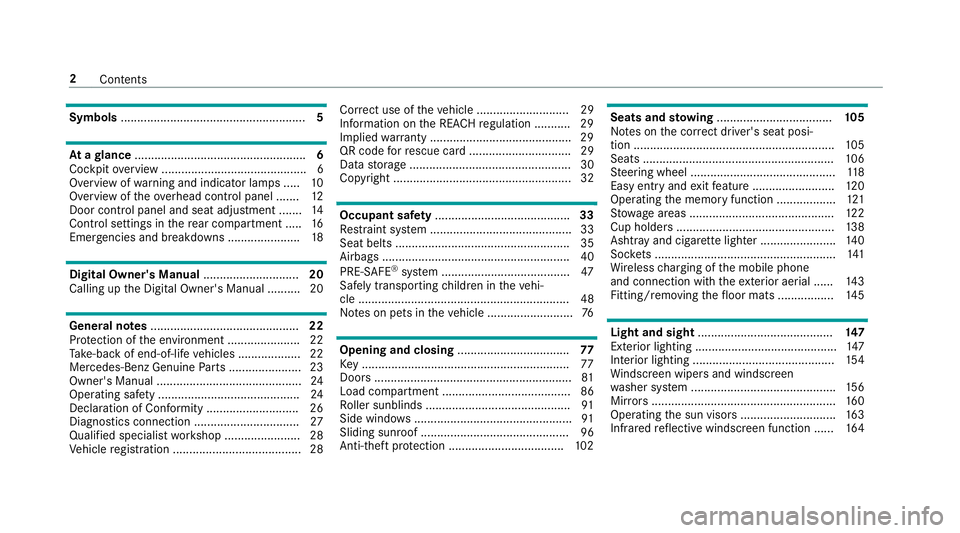
Symbols
........................................................ 5At
agl ance .................................................... 6
Cockpit overview ............................................ 6
Overview of warning and indicator lamps .... .10
Overview of theove rhead control panel .......12
Door control panel and seat adjustment ....... 14
Control settings in there ar compartment .... .16
Emergencies and breakdowns ...................... 18Digital Owner's Manual
.............................20
Calling up the Digital Owner's Manual ..........20 Genera
l notes............................................. 22
Pr otection of the environment ......................22
Ta ke -ba ckof end-of-life vehicles ...................22
Mercedes-Benz Genuine Parts ......................23
Owner's Manual ............................................ 24
Operating saf ety .......................................... .24
Declaration of Conformity ............................ 26
Diagno stics connection ................................ 27
Qualified specialist workshop ....................... 28
Ve hicle registration ....................................... 28 Cor
rect use of theve hicle ............................29
Information on the REA CHregulation ........... 29
Implied warranty .......................................... .29
QR code forre scue card ...............................29
Data storage .................................................30
Copyright ...................................................... 32 Occupant saf
ety......................................... 33
Re stra int sy stem ...........................................33
Seat belts ..................................................... 35
Airbags ......................................................... 40
PRE-SAFE ®
sy stem ....................................... 47
Safely transporting children in theve hi‐
cle ................................................................48
No tes on pets in theve hicle .......................... 76 Opening and closing
.................................. 77
Ke y .............................................................. .77
Doo rs............................................................ 81
Load compartment ....................................... 86
Ro ller sunblinds ............................................ 91
Side windo ws................................................ 91
Sliding sunroof ............................................. 96
Anti-theft pr otection ................................... 102 Seats and
stowing ................................... 105
No tes on the cor rect driver's seat posi‐
tion ............................................................. 105
Seats .......................................................... 106
St eering wheel ............................................ 11 8
Easy entry and exitfeature ........................ .120
Operating the memory function .................. 121
St ow age areas ............................................ 12 2
Cup holders ................................................ 13 8
Ashtr ayand cigar ette lighter ...................... .140
Soc kets ....................................................... 141
Wi reless charging of the mobile phone
and connection with theex terior aerial ...... 14 3
Fitting/removing thefloor mats ................. 14 5 Light and sight
......................................... 147
Exterior lighting ........................................... 147
Interior lighting ........................................... 154
Wi ndsc reen wipers and windscreen
wa sher sy stem ............................................ 15 6
Mir rors ........................................................ 16 0
Operating the sun visors ............................. 16 3
Infrared reflective windscreen function ...... 16 42
Contents
Page 6 of 681
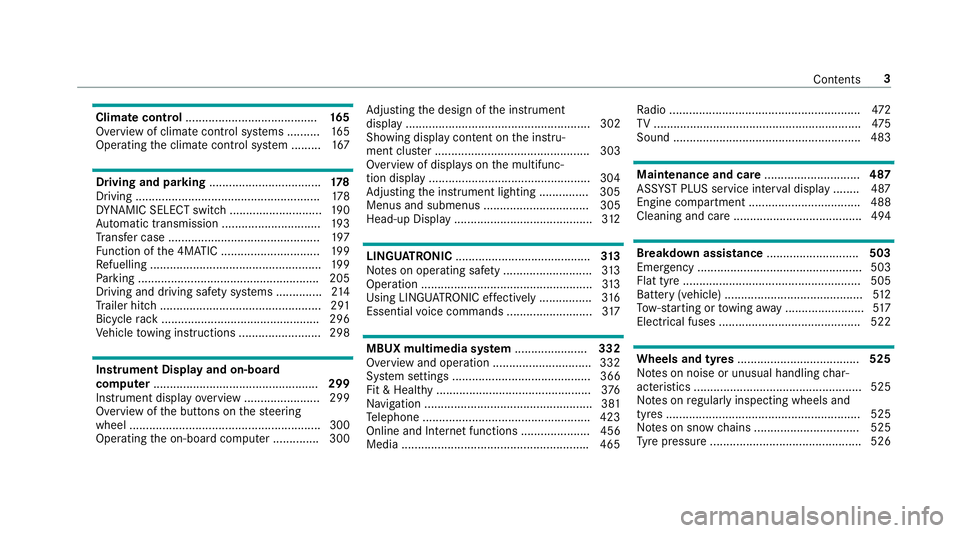
Climate control
........................................ 16 5
Overview of climate contro l systems ..........1 65
Operating the climate control sy stem ......... 167 Driving and pa
rking .................................. 17 8
Driving ........................................................ 178
DY NA MIC SELECT switch ............................1 90
Au tomatic transmission .............................. 19 3
Tr ans fer case .............................................. 197
Fu nction of the 4MATIC .............................. 19 9
Re fuelling .................................................... 19 9
Pa rking ...................................................... .205
Driving and driving saf ety sy stems .............. 214
Tr ailer hit ch................................................. 291
Bicycle rack ................................................ 296
Ve hicle towing instructions ........................ .298 Instrument Display and on-board
comp uter.................................................. 299
Instrument display overview ...................... .299
Overview of the buttons on thesteering
wheel ..........................................................3 00
Operating the on-board computer .............. 300 Ad
justing the design of the instrument
display ........................................................ 302
Showing display conte nt onthe instru‐
ment clus ter ............................................... 303
Overview of displa yson the multifunc‐
tion display .................................................3 04
Ad justing the instrument lighting ............... 305
Menus and submenus ................................ 305
Head-up Display .......................................... 312 LINGU
ATRO NIC ......................................... 313
No tes on operating saf ety .......................... .313
Operation ....................................................3 13
Using LINGU ATRO NIC ef fectively ................ 316
Essential voice commands .......................... 317 MBUX multimedia sy
stem ...................... 332
Overview and operation .............................. 332
Sy stem settings .......................................... 366
Fit & Healt hy............................................... 376
Na vigation ................................................... 381
Te lephone .................................................. .423
Online and Internet functions ..................... 456
Media ........................................................ .465 Ra
dio .......................................................... 472
TV ............................................................... 475
Sound ......................................................... 483 Main
tenance and care ............................. 487
ASS YST PLUS service inter val display ........ 487
Engine compartment .................................. 488
Cleaning and care ...................................... .494 Breakdown assistance
............................503
Emergency .................................................. 503
Flat tyre ...................................................... 505
Battery (vehicle) .......................................... 512
To w- starting or towing away ........................ 517
Electrical fuses ........................................... 522 Wheels and tyres
..................................... 525
No tes on noise or unusual handling char‐
acteristics .................................................. .525
No tes on regularly inspecting wheels and
tyres ........................................................... 525
No tes on snow chains ................................ 525
Ty re pressure .............................................. 526 Contents
3
Page 10 of 681
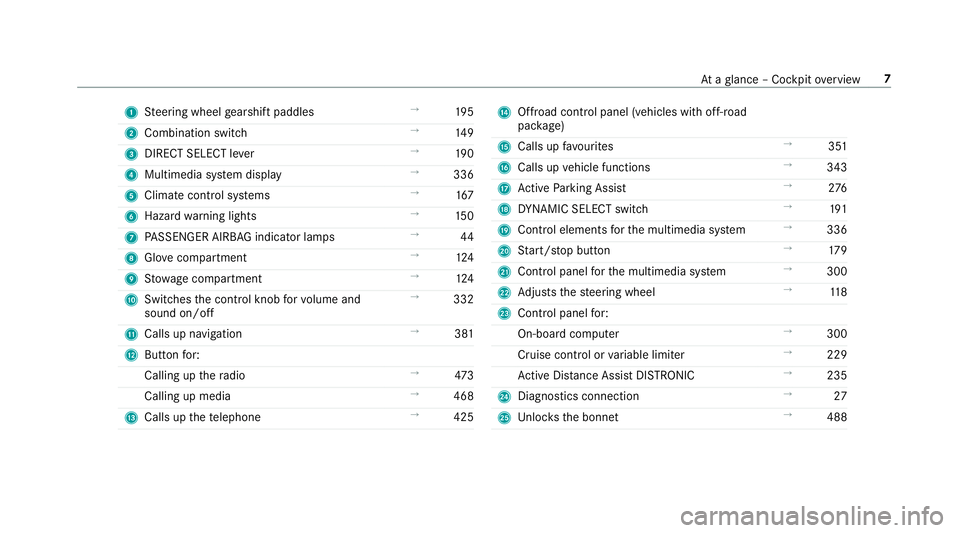
1
Steering wheel gearshift paddles →
19 5
2 Combination swit ch →
14 9
3 DIRECT SELECT le ver →
19 0
4 Multimedia sy stem display →
336
5 Climate control sy stems →
167
6 Haza rdwa rning lights →
15 0
7 PASSENGER AIRB AGindicator lamps →
44
8 Glovecompa rtment →
124
9 Stow age compartment →
124
A Switches the control knob forvo lume and
sound on/off →
332
B Calls up navigation →
381
C Buttonfo r:
Calling up thera dio →
473
Calling up media →
468
D Calls up thete lephone →
425 E
Offroad control panel (vehicles with off- road
pac kage)
F Calls up favo urites →
351
G Calls up vehicle functions →
343
H Active Parking Assist →
276
I DYNA MIC SELECT switch →
191
J Control elements forth e multimedia sy stem →
336
K Start/ stop button →
17 9
L Control panel forth e multimedia sy stem →
300
M Adjusts thesteering wheel →
11 8
N Control panel for:
On-board computer →
300
Cruise contro l orvariable limiter →
229
Ac tive Dis tance Assi stDISTRONIC →
235
O Diagno stics connection →
27
P Unloc ksthe bonn et →
488 At
aglance – Cockpit overview 7
Page 11 of 681
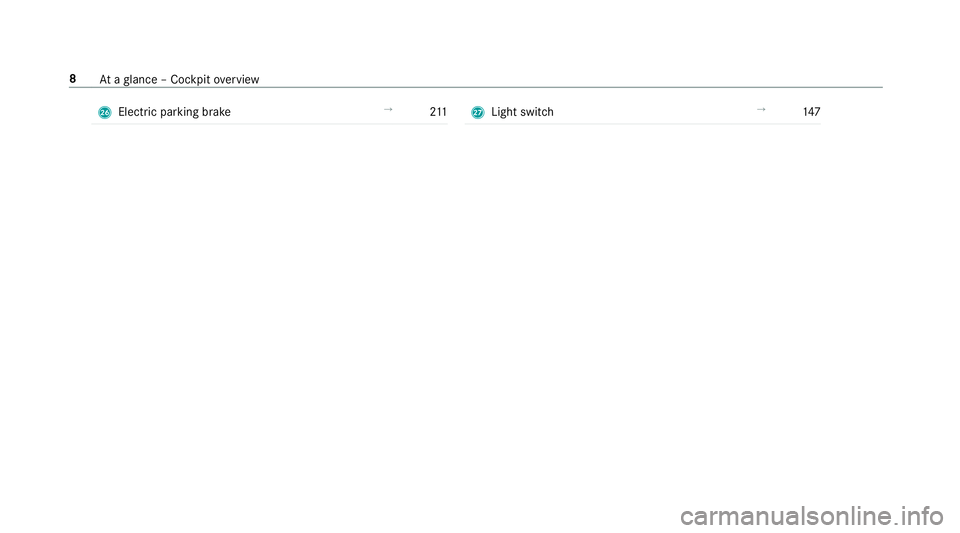
Q
Electric pa rking brake →
211 R
Light switch →
147 8
Ataglance – Cockpit overview
Page 14 of 681
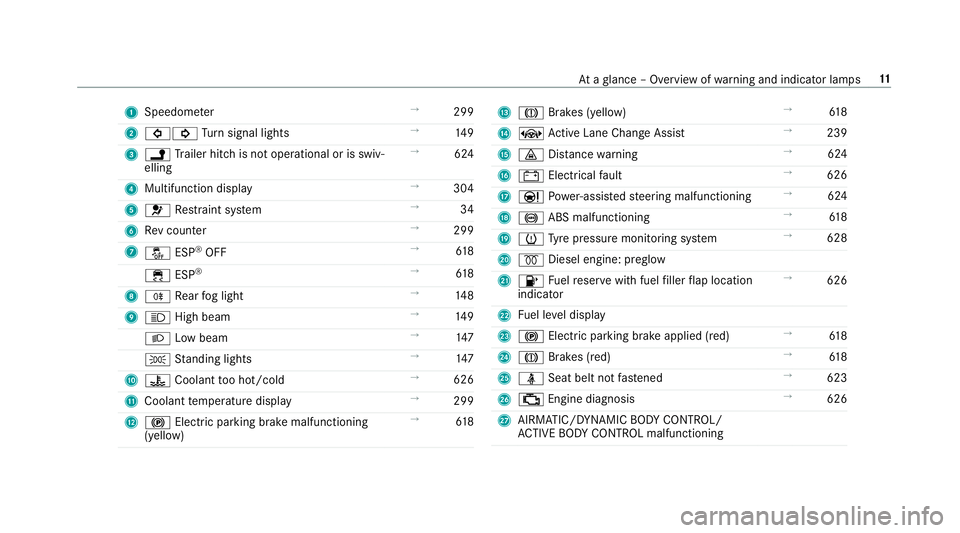
1
Speedom eter →
299
2 #! Turn signal lights →
14 9
3 j Trailer hit chis not operational or is swiv‐
elling →
624
4 Multifunction display →
304
5 6 Restra int sy stem →
34
6 Rev counter →
299
7 å ESP®
OFF →
61 8
÷ ESP®
→
61 8
8 R Rear fog light →
14 8
9 K High beam →
14 9
L Low beam →
147
T Standing lights →
147
A ? Coolant too hot/cold →
626
B Coolant temp erature display →
299
C ! Electric pa rking brake malfunctioning
(yellow) →
61 8 D
J Brakes (yell ow) →
61 8
E ± Active Lane Change Assi st→
239
F · Distance warning →
624
G # Electrical fault →
626
H Ð Powe r-assis tedsteering malfunctioning →
624
I ! ABS malfunctioning →
61 8
J h Tyre pressure monitoring sy stem →
628
K % Diesel engine: preglow
L 8 Fuelreser vewith fuel filler flap location
indicator →
626
M Fuel le vel display
N ! Electric parking brake applied (red) →
61 8
O J Brakes (red) →
61 8
P ü Seat belt not fastened →
623
Q ; Engine diagnosis →
626
R AIRMATIC/DYNAMIC BODY CONTROL/
AC TIVE BODY CONTROL malfunctioning At
aglance – Overview of warning and indicator lamps 11
Page 16 of 681
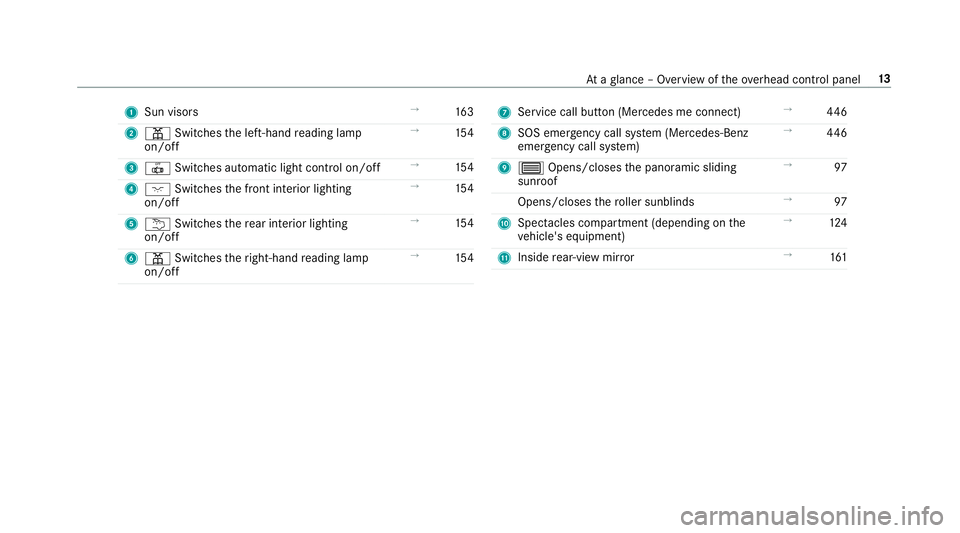
1
Sun visors →
16 3
2 p Switches the left-hand reading lamp
on/off →
154
3 | Switches au tomatic light control on/off →
154
4 c Switches the front interior lighting
on/off →
154
5 u Switches there ar interior lighting
on/off →
154
6 p Switches theright-hand reading lamp
on/off →
154 7
Service call button (Me rcedes me connect) →
446
8 SOS emergency call sy stem (Mercedes-Benz
emer gency call sy stem) →
446
9 3 Opens/closes the panoramic sliding
sunroof →
97
Opens/closes thero ller sunblinds →
97
A Spectacles compa rtment (depending on the
ve hicle's equipment) →
124
B Inside rear-view mir ror →
161 At
aglance – Overview of theov erhead control panel 13
Page 22 of 681
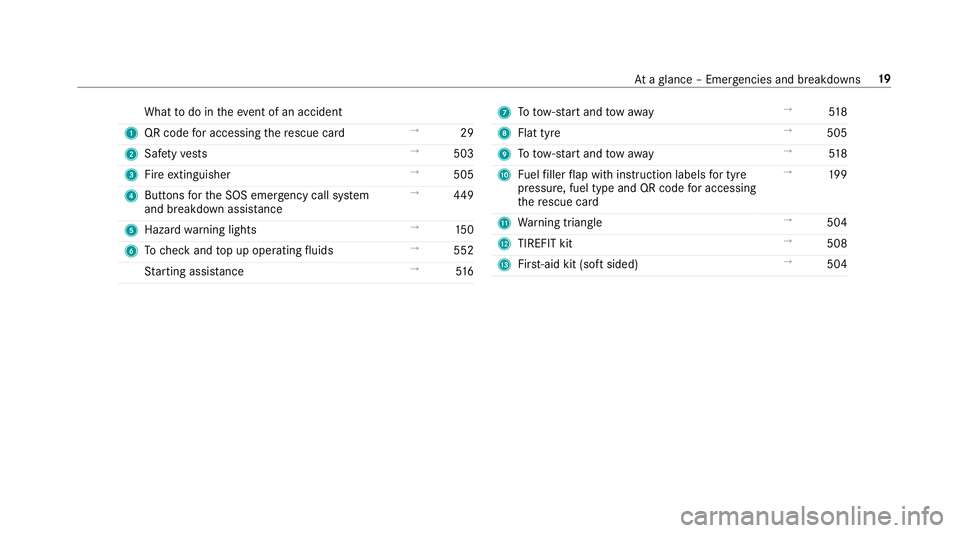
What
todo in theeve nt of an accident
1 QR code for accessing there scue card →
29
2 Safetyve sts →
503
3 Fire extinguisher →
505
4 Buttons forth e SOS emer gency call sy stem
and breakdown assis tance →
449
5 Haza rdwa rning lights →
15 0
6 Tocheck and top up operating fluids →
552
St arting assis tance →
516 7
Totow- start and tow aw ay →
51 8
8 Flat tyre →
505
9 Totow- start and tow aw ay →
51 8
A Fuelfiller flap with instruction labels for tyre
pressu re, fuel type and QR code for accessing
th ere scue card →
19 9
B Warning triangle →
504
C TIREFIT kit →
508
D First-aid kit (so ftsided) →
504 At
aglance – Emer gencies and breakdowns 19
Page 33 of 681
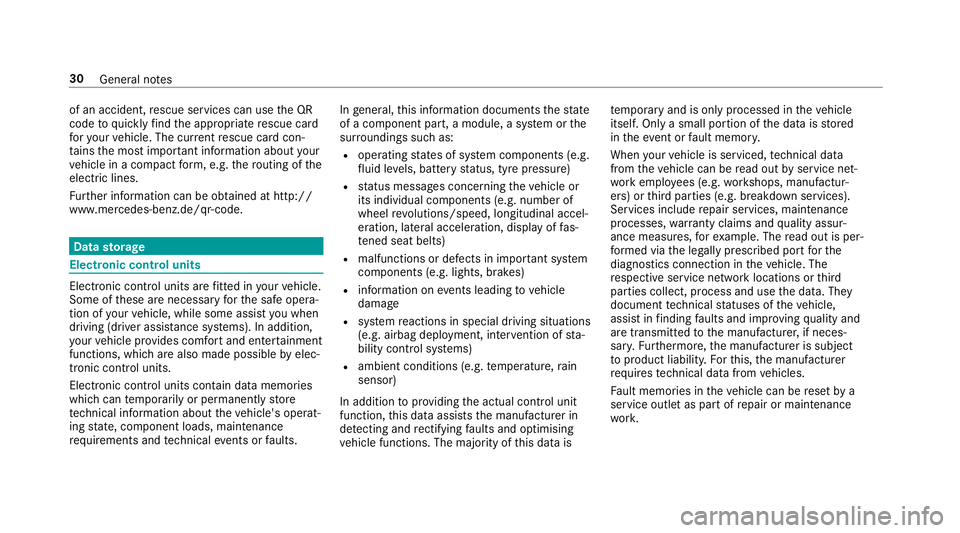
of an accident,
rescue services can use the QR
code toquickly find the appropriate rescue card
fo ryo ur vehicle. The cur rent rescue card con‐
ta ins the most impor tant information about your
ve hicle in a compact form , e.g. thero uting of the
electric lines.
Fu rther information can be obtained at http://
www.mercedes-benz.de/qr-code. Data
storage Electronic control units
Elect
ronic control units are fitted in your vehicle.
Some of these are necessary forth e safe opera‐
tion of your vehicle, while some assist you when
driving (driver assis tance sy stems). In addition,
yo ur vehicle pr ovides com fort and enter tainment
functions, which are also made possible byelec‐
tronic control units.
Elect ronic control units contain da tamemories
which can temp orarily or permanently store
te ch nical information about theve hicle's operat‐
ing state, component loads, main tenance
re qu irements and tech nical events or faults. In
general, this information documents thest ate
of a component part, a module, a sy stem or the
sur roundings such as:
R operating states of sy stem components (e.g.
fl uid le vels, battery status, tyre pressure)
R status messages concerning theve hicle or
its individual components (e.g. number of
wheel revo lutions/speed, longitudinal accel‐
eration, lateral acceleration, display of fas‐
te ned seat belts)
R malfunctions or de fects in impor tant sy stem
components (e.g. lights, brakes)
R information on events leading tovehicle
damage
R system reactions in special driving situations
(e.g. airbag deployment, inter vention of sta‐
bility control sy stems)
R ambient conditions (e.g. temp erature, rain
sensor)
In addition toprov iding the actual control unit
function, this data assists the manufacturer in
de tecting and rectifying faults and optimising
ve hicle functions. The majority of this data is te
mp orary and is only processed in theve hicle
itself. Only a small portion of the data is stored
in theev ent or fault memor y.
When your vehicle is serviced, tech nical da ta
from theve hicle can be read out byservice net‐
wo rkemplo yees (e.g. workshops, manufactur‐
ers) or third parties (e.g. breakdown services).
Services include repair services, maintenance
processes, warranty claims and quality assur‐
ance measures, forex ample. The read out is per‐
fo rm ed via the legally prescribed port forthe
diagnostics connection in theve hicle. The
re spective service network locations or third
parties collect, process and use the data. They
document tech nical statuses of theve hicle,
assist in finding faults and impr oving quality and
are transmit tedto the manufacturer, if neces‐
sar y.Fu rthermore, the manufacturer is subject
to product liability. Forth is, the manufacturer
re qu ires tech nical da tafrom vehicles.
Fa ult memories in theve hicle can be reset by a
service outlet as part of repair or maintenance
wo rk. 30
General no tes
Page 34 of 681
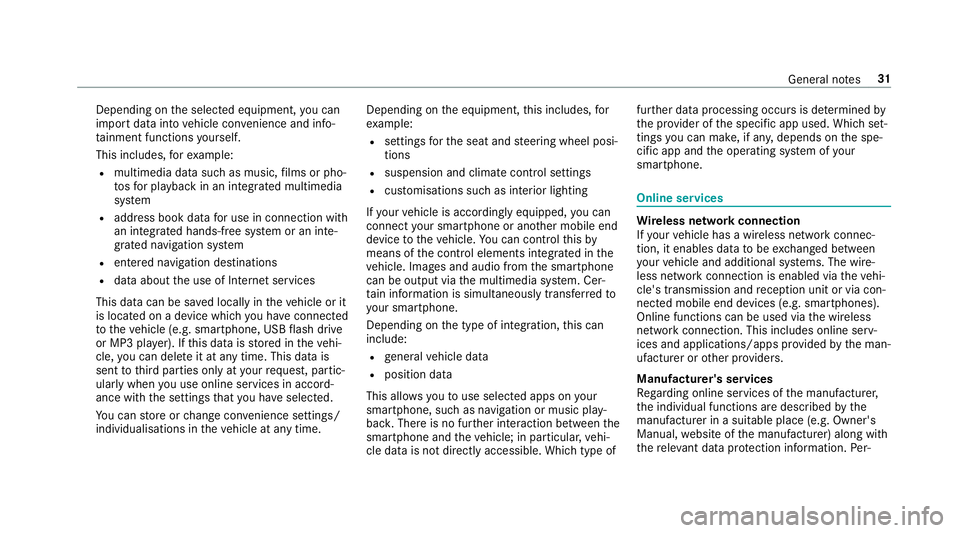
Depending on
the selected equipment, you can
import data into vehicle con venience and info‐
ta inment functions yourself.
This includes, forex ample:
R multimedia data such as music, films or pho‐
to sfo r playback in an integrated multimedia
sy stem
R address book data for use in connection with
an integrated hands-free sy stem or an inte‐
grated navigation sy stem
R entered navigation destinations
R data about the use of Internet services
This data can be sa ved locally in theve hicle or it
is located on a device which you ha veconnected
to theve hicle (e.g. smartphone, USB flash drive
or MP3 pla yer). If this data is stored in theve hi‐
cle, you can dele teit at any time. This data is
sent tothird parties only at your requ est, partic‐
ular lywhen you use online services in accord‐
ance with the settings that you ha veselected.
Yo u can store or change con venience settings/
individualisations in theve hicle at any time. Depending on
the equipment, this includes, for
ex ample:
R settings forth e seat and steering wheel posi‐
tions
R suspension and climate control settings
R customisations such as interior lighting
If yo ur vehicle is accordingly equipped, you can
connect your smartphone or ano ther mobile end
device totheve hicle. You can cont rolth is by
means of the control elements integrated in the
ve hicle. Images and audio from the smartphone
can be output via the multimedia sy stem. Cer‐
ta in information is simultaneously transfer redto
yo ur smartphone.
Depending on the type of integration, this can
include:
R general vehicle data
R position data
This allo wsyouto use selected apps on your
smartphone, such as navigation or music play‐
bac k.There is no fur ther interaction between the
smartphone and theve hicle; in particular, vehi‐
cle data is not directly accessible. Which type of fur
ther data processing occurs is de term ined by
th e pr ovider of the specific app used. Which set‐
tings you can make, if an y,depends on the spe‐
cific app and the operating sy stem of your
smartphone. Online services
Wire
less network connection
If yo ur vehicle has a wireless network connec‐
tion, it enables data tobe exc hanged between
yo ur vehicle and additional sy stems. The wire‐
less network connection is enabled via theve hi‐
cle's transmission and reception unit or via con‐
nected mobile end devices (e.g. sma rtphones).
Online functions can be used via the wireless
network connection. This includes online serv‐
ices and applications/apps pr ovided bythe man‐
ufacturer or other pr oviders.
Manu factu rer's se rvices
Re garding online services of the manufacturer,
th e individual functions are described bythe
manufacturer in a suita ble place (e.g. Owner's
Manual, website of the manufacturer) along with
th ere leva nt da taprotection information. Per‐ General no
tes31
Page 37 of 681

Re
stra int sy stem functionality When
the ignition is switched on, a self-test is
per form ed, during which the6 restra int sys‐
te m wa rning lamp lights up. It goes out no later
th an a few seconds af terth eve hicle is star ted.
The components of there stra int sy stem are then
functional. Malfunctioning
restra int sy stem A malfunction has occur
red in there stra int sys‐
te m if:
R the6 restra int sy stem warning lamp does
not light up when the ignition is switched on
R the6 restra int sy stem warning lamp
lights up continuously or repeatedly during a
journey &
WARNING Risk of inju ryor fata l injury
due toa malfunction in there stra int sys‐
tem
If th ere stra int sy stem is malfunctioning,
re stra int sy stem components may be trig‐ ge
red unintentionally or might not be trig‐
ge red at all in theev ent of an accident. This
may af fect the seat belt tensioner or airbag,
fo rex ample. #
Have there stra int sy stem checked and
re paired immediately at a qualified spe‐
cialist workshop. Fu
nction of there stra int sy stem in an acci‐
dent How
there stra int sy stem works is de term ined by
th e se verity of the impact de tected and the type
of accident anticipated:
R Frontal impact
R Rear impact
R Side impact
R Rollover
The activation thre sholds forth e components of
th ere stra int sy stem are de term ined based on
th eev aluation of the sensor values measured at
va rious points in theve hicle. This process is pre-
em ptive in nature. The triggering/deployment of th
e components of there stra int sy stem must
ta ke place in good time at thest art of the colli‐
sion.
Fa ctors whi chcan only be seen and measu red
af te r a collision has occur red do not play a deci‐
sive role in the deployment of an airbag. Nordo
th ey prov ide an indication of airbag deployment.
The vehicle may be deformed significantly with‐
out an airbag being deplo yed. This is the case if
only parts which are relatively easily deformed
are af fected and thera te ofvehicle deceleration
is not high. Con versely, an airbag may be
deplo yedev en though theve hicle suf fers only
minor deformation. If very rigid vehicle parts
such as longitudinal members are hit, forex am‐
ple, this may result in suf ficiently high le vels of
ve hicle deceleration. 34
Occupant saf ety